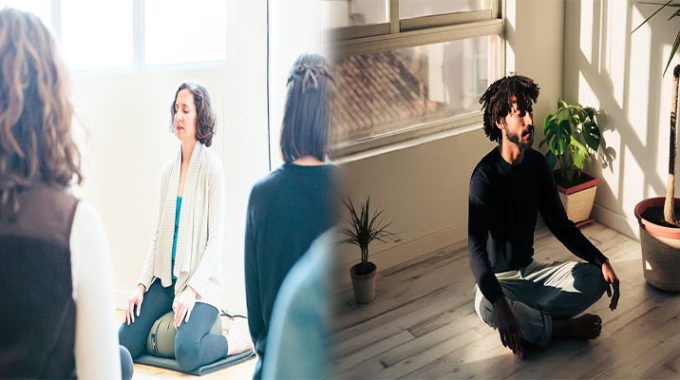Meditating is one of the best things you can do for your health and mental well-being. It can help reduce stress, anxiety and depression while promoting happiness and positivity. And it’s not just a fad or trend—meditation has been around for thousands of years, likely because it works. If you’re new to meditation or want to learn more about how to start a regular practice, here are some tips from experts on how to build a meditation habit:
Meditation has many mental, emotional and physical health benefits.
Meditation can help you get to sleep, reduce stress and anxiety, increase focus and attention span, manage pain more effectively and improve overall mental health.
Meditation has also been shown to help with depression. In fact, one study published in The Journal of Clinical Psychiatry found that meditation was just as effective as antidepressants at treating major depressive disorder (MDD).
The benefits of meditation go beyond mental health: It’s been shown that the practice may help with weight loss by lowering blood pressure and reducing inflammation–which could mean fewer flare-ups of chronic conditions like diabetes or arthritis.
There are different types of meditation.
There are many different types of meditation. The goal of all types is to help you relax and focus your mind. Meditation is not about religion or spirituality; it’s simply a tool that can be used by anyone, regardless of their beliefs.
The purpose of this article is to give you some ideas for how you might start meditating on a regular basis, so let’s take a look at some different types of meditation!
Meditation can be done anywhere.
While meditation is often thought of as a practice that can only be done in a special place, this isn’t true. Meditation can be done anywhere–even if you don’t have a special room or space set up for it. You don’t need any fancy equipment or extra time on your schedule; all you need is yourself and the desire to meditate.
The idea that meditation requires a specific location might come from the fact that many people use meditation apps such as Headspace or Calm (both of which have free introductory programs), which offer guided audio instructions for meditating at home or even while traveling on public transportation during rush hour traffic jams! If these kinds of apps aren’t your thing but still want some guidance when starting out with mindfulness exercises like those found in Buddhism-based practices like Vipassana (also known as insight) then check out my favorite book by author Thich Nhat Hanh called “For A Future To Be Possible”.
Meditation won’t make you feel weird or uncomfortable.
Meditation is not about feeling weird or uncomfortable. It’s about becoming aware of your thoughts and feelings and not judging them. It’s about being present in the moment, rather than lost in some memory or future goal.
Meditation is a natural state of mind that we all experience every day–but we don’t realize it because we’re too busy thinking about other things! If you’ve ever been so absorbed by something that everything else faded away into the background for a minute, then congratulations: You meditated!
You don’t have to follow a certain routine to meditate.
You don’t have to follow a certain routine to meditate.
You can meditate for as long as you want and then stop when you’re done, or vice versa. You can also decide that every day is going to be different, which is what I do now–I set my alarm clock an hour earlier than usual so I have more time in the morning, and then spend 30 minutes sitting still with my eyes closed before starting my day. It’s not essential that this be your routine either; it just works well for me!
You can meditate for as little as three minutes a day or as long as 30 minutes, depending on what works for you and your schedule.
There are no hard and fast rules about how long to meditate. If you’re a beginner, three minutes is a good place to start. If you’re an experienced meditator, 30 minutes might be right for you–and if not, then maybe 15 or 20 will be better. But don’t worry too much about it: whatever works best for your schedule and lifestyle will work just fine!
You can meditate anywhere as long as there’s some peace and quiet around; even just closing the door of your bedroom will help create an environment where distractions aren’t likely to pop up (although they may still try).
There are many apps that can help you meditate, but they’re not required if you want to start meditating without them.
There are many apps that can help you meditate, but they’re not required if you want to start meditating without them.
You can meditate for as little as three minutes a day or as long as 30 minutes, depending on what works for you and your schedule. There is no right or wrong way to meditate; just do what feels right and comfortable for you at any given time of day. Don’t worry about how long it takes either–it’s better to focus on being mindful than worrying about how much time has passed!
Meditation is very simple but it takes some work to build into a habit
Meditation is easy to learn, but it takes some work to build into a habit. Here are some tips:
- You can meditate anywhere. You don’t need special equipment or even quiet surroundings–just find a comfortable place where you won’t be disturbed for the duration of your meditation session (about 20 minutes). If you’re at home, try sitting up against a wall or lying down on your bed with eyes closed; if you’re at work or school, use an empty conference room or find somewhere quiet where people won’t disturb you as they pass by. You can also try doing simple breathing exercises whenever possible throughout the day (for example, when waiting in line for coffee). This will help strengthen mindfulness skills that will make it easier for them later when trying longer sessions!
- It doesn’t matter how long each session lasts either; just focus on being present in each moment without judging yourself negatively about whether “this isn’t working” or whatever else may come up during practice time.”
Meditation can be a very rewarding practice, but it does take some work to build into a habit. The best thing about it is that you don’t need fancy equipment or even an app to get started–just some time and space where no one else will disturb you. If you want to try meditating but aren’t sure where to start, consider following these simple steps:














